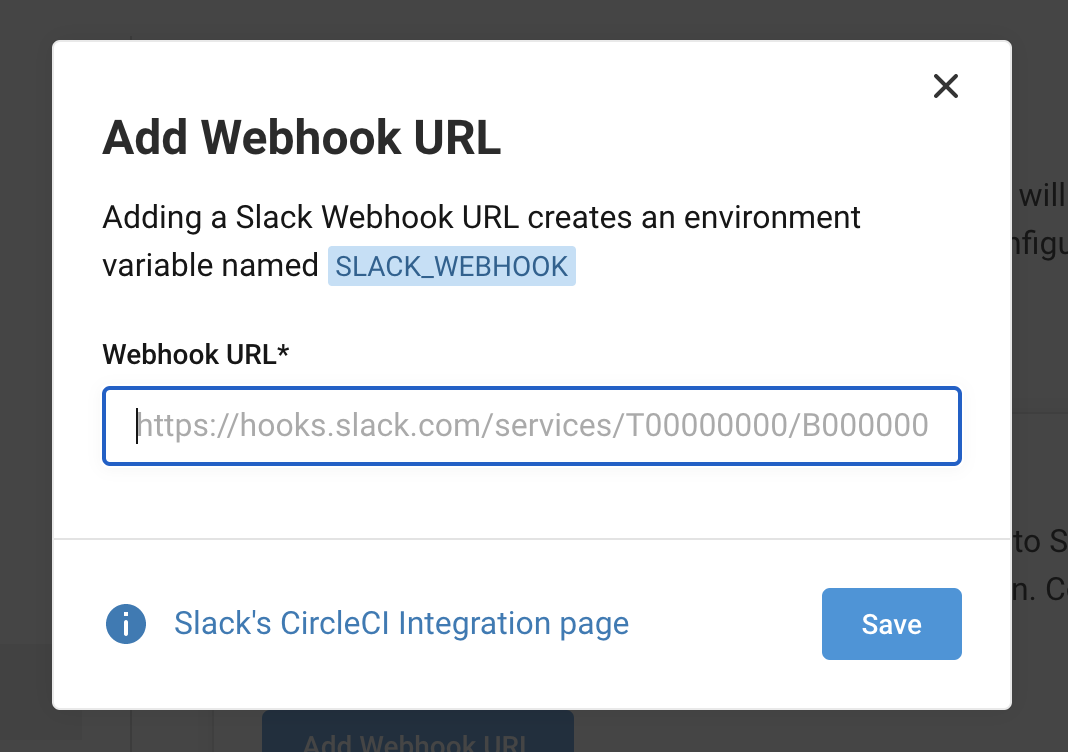追記
現在(slack orb v4)は新しい連携方法に変わっています↓
以下(slack orb v3)は古い連携方法です。
概要
旧UIでは以下のような設定画面でslack連携を行っていましたが

新UIからはこの設定方法はサポートされなくなり、新しくSlack Orbを使った設定方法に変わりました。
環境
- CircleCI 2.1
- circleci/slack 3.4.2
設定方法
新UIでのslack連携は以下の2ステップです。
- 環境変数の設定
- Orbの設定
環境変数の設定
Slack Integrationのところから設定できます。

Webhook URLを入力します。

こうするとSlack Orbで使う環境変数が設定されます。

Orbの設定
Slack Orbには現状1つのJobと4つのCommandがあります。
- Jobs
- Commands
この中でよく使うのはjobの成功、失敗を通知するstatusになるかと思います。
以下のように設定します。
version: 2.1 orbs: slack: circleci/slack@3.4.2 jobs: build: docker: - image: cimg/base:stable steps: - run: name: Build command: make build - slack/status
こうすると失敗時には

成功時には

といった通知が飛びます。
ただし注意としてstatusはcommandなのでworkflow毎に設定できず、job毎に設定する必要があります。
Tips
以下Tipsです。
失敗時だけ通知したい
先程の設定だと成功時も通知されるため、workflowで以下のようなpipelineを組むと各jobで通知が飛んでうるさいです。

なのでfail_only: trueで失敗時のみ通知する形にすると毎回飛ぶことを防げます。
version: 2.1 orbs: slack: circleci/slack@3.4.2 executors: default: docker: - image: cimg/base:stable jobs: build: executor: default steps: - run: name: Build command: make build - slack/status: fail_only: true test: executor: default steps: - run: name: Test command: make test - slack/status: fail_only: true workflows: version: 2 build_and_test: jobs: - build: filters: branches: ignore: master - test: requires: - build
でもworkflowの最後には成功も通知したい
愚直に最後のjobのときはfail_only: trueを付けないようにします。公式もこのやり方だと説明しています。
公式ではpost-stepsを活用することでjobでなくworkflowで管理する方法を紹介しています。
jobs: build: executor: default steps: - run: name: Build command: make build test: executor: default steps: - run: name: Test command: make test workflows: version: 2 build_and_test: jobs: - build: filters: branches: ignore: master post-steps: - slack/status: fail_only: true - test: requires: - build post-steps: - slack/status
並列なpipelineの場合
また直列でなく並列なpipelineの場合は、通知用のジョブを作って並行部分をrequireする必要があります。
かなり面倒ですね。

jobs: build: executor: default steps: - run: name: Build command: make build test: executor: default steps: - run: name: Test command: make test coverage: executor: default steps: - run: name: Coverage command: make cover integration_test: executor: default steps: - run: name: Integration Test command: make test-integration notify_workflow_end: executor: default steps: - slack/status: success_message: ':tada: A PR build has succeeded!' workflows: version: 2 build_and_test: jobs: - build: filters: branches: ignore: master post-steps: - slack/status: fail_only: true - test: requires: - build post-steps: - slack/status: fail_only: true - coverage: requires: - build post-steps: - slack/status: fail_only: true - integration_test: requires: - build post-steps: - slack/status: fail_only: true - notify_workflow_end: requires: - test - coverage - integration_test
何回も同じことを書くのを避けたい
jobが増えてくると同じような記述も増えるのでできるだけスリムにしたいですね。2通りあります。
commandsを使う
CirlceCI 2.1のcommandsを使う方法です。
commands: notify_failure: steps: - slack/status: fail_only: true workflows: version: 2 build_and_test: jobs: - build: filters: branches: ignore: master post-steps: - notify_failure - test: requires: - build post-steps: - notify_failure - coverage: requires: - build post-steps: - notify_failure - integration_test: requires: - build post-steps: - notify_failure - notify_workflow_end: requires: - test - coverage - integration_test
Yamlのアンカーとマージを使う
もう1つはYamlのアンカーとマージ機能を使う方法です。
notify_failure: ¬ify_failure post-steps: - slack/status: fail_only: true workflows: version: 2 build_and_test: jobs: - build: filters: branches: ignore: master <<: *notify_failure - test: requires: - build <<: *notify_failure - coverage: requires: - build <<: *notify_failure - integration_test: requires: - build <<: *notify_failure - notify_workflow_end: requires: - test - coverage - integration_test
まとめ
- Orbを使うことでプラガブルになった
- コードベースになって設定が統一されやすくなった
のは良い一方、以前よりユーザ側の設定が増えて使いづらくなった印象がありますね。
今後のDXの改善に期待したいです。